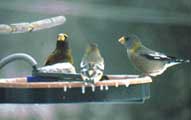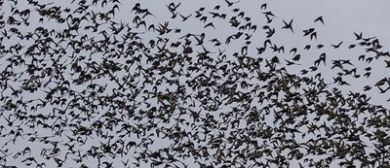Blog - General
Dave’s 2012 November Bird Chatter
Once again as, in millenniums past, ducks will begin slowly drifting south for the winter. Then as the cold Arctic fronts begin to blow from the north the geese will be moving south as well. While some may think this is the “bird migration”, it is actually nearly complete. Song birds began their migration back in August. And as we watch the last of them depart this month, we will begin to see those migrant birds appear which move into the Central Plains from the North Country to spend winter. From the Dark-eyed Juncos and Pine Siskin, to the Red-breasted Nuthatches and Sapsuckers, many new birds will arrive for us to watch during the winter.
One thing is certain about migration whether in the spring or the fall. One never knows what unusual or rare bird may be just outside his window, or just around the next corner along the trail. That is a good enough reason to make sure you have a field guide and take on the challenge of identifying that new bird you see. It is also a good idea to have a pair of binoculars handy. They will help you collect the visual information needed to make a positive identification. Bird watchers prefer 8 X 35 or 8 X 40 binoculars. The price ranges from $50.00 to $1000.00 and more. Depending on the clarity of the lens, amount of light let in, and comfort for long walks. For most backyard bird watching, the investment can be minimal but I guarantee they will be worth their weight in gold.

When I set up my first bird bath it was cold, windy, and snow was in the forecast. I knew then the following year I was going to get ready while the weather was still fairly nice. Maybe your bird bath needs to be re-leveled, cleaned out, or the heater tested to make sure it is still in working order. Maybe this is the year your going to add a water feature to your backyard in the form of a bird bath and heater, or one of the heated bird baths available. Whatever the case, I suggest you take advantage of the lingering fall temperatures to prepare now. You’ll be glad you did and it will be very beneficial for your backyard birds in the months to come.
Wingtip:
If you have scale and lime deposits have built up on your bird bath heater from last year’s use it may not function properly. The build up can be easily removed by soaking your heater in white vinegar and using a brush to loosen the deposits. Remember most ofthe bird bath heaters are thermostatically controlled. If you plug it in and it does not warm up, maybe it is not cold enough to switch on. You may test by placing the bird bath heater in your freezer for 20 minutes. Remove and plug in. If it is still working properly it will switch on and you’ll feel it begin to warm up. Also, check the outlet you have it plugged into to make sure you have power to the bird bath heater. And avoid using extension cords over 50 feet. The longer the cord the more difficult it is to get the proper power to your bird bath heater to perform properly.

The blackbirds are now massing together in huge flocks as the days grow shorter and slowly become cooler. Hordes of them are riding the strong north winds south. In the mornings I have 8 to 10 Cardinals at the feeders along with nuthatches, Chickadees, White-crowned Sparrows, some newly arrive Juncos, Jays and doves. They return to feast in the evening before going to roost. But during the day it seems the blackbirds dominate, but that’s alright. These flocks of blackbirds are as much a sign of fall as dropping leaves, cloudy days, red sunsets and Halloween. Those blackbirds that nested here during the summer are no doubt long gone, and what we see now are flocks from the north passing through. Very soon they all will have departed.
The northern population of Goldfinch will begin arriving throughout November and are the primary Goldfinch at our feeders during the winter months. Many of our resident adult Goldfinches will drift south into the southern plains abandoning some of the first year birds who will remain. For the past two months our Goldfinch have rarely been seen at the Nyjer thistle feeders preferring to feast in rural areas on the ripened Tall Prairie Thistle and other seeds now available. They can be seen balancing on the seed heads of coneflowers and sunflowers. When they do return to our bird feeders this month the males will be in their basic plumage of olive drab similar to that of the female Goldfinch. I’m still hoping we see a good number of Pine Siskin arriving with the northern Goldfinches to spend the winter here.
Already we have had reports of new birds arriving, some only to pass through. Goldfinch, Red-breasted Nuthatches, White-crowned Sparrows, Swainson’s thrush, a variety of warblers including a Black-throated Blue Warbler that Linda and I watched I watched at our backyard avian pond for several days in a row. It is an exciting time. All one has to do is look to see many new birds.
